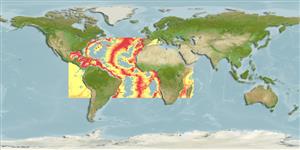>
Aulopiformes (Grinners) >
Ipnopidae (Deep-sea tripod fishes) > Ipnopinae
Etymology: Bathypterois: Greek, bathys = deep + Greek, pterois = with wings (Ref. 45335).
More on authors: Goode & Bean.
Environment: milieu / climate zone / rango de profundidad / distribution range
Ecología
marino batidemersal; rango de profundidad 878 - 4720 m (Ref. 58302). Deep-water; 45°N - 27°S, 98°W - 52°E
Tropical to warm temperate Atlantic, Indian and Western Central Pacific oceans. Western Atlantic: eastern seaboard of the U.S. from about 40°N to the Gulf of Mexico and the Caribbean..
Tamaño / Peso / Age
Madurez: Lm ? range ? - ? cm
Max length : 43.4 cm TL macho / no sexado; (Ref. 37039); common length : 30.0 cm SL macho / no sexado; (Ref. 3590)
Short description
Claves de identificación | Morfología | Morfometría
Elongate pelvic and caudal fin rays held body above the sediment. These rays appeared flexible when the fishes swam and stiff when they were perched on the bottom (Ref. 7460).
Benthic (Ref. 58302). Found on lower slope, continental rise and oceanic ridges. Solitary. Perches on substrate with the aid of specialized fin rays (tripod), facing the current. Feeds on nektonic copepods and other small planktonic crustaceans. Synchronously hermaphroditic (Ref. 6688).
Life cycle and mating behavior
Madurez | Reproducción | Puesta | Huevos | Fecundidad | Larva
Merrett, N.R., 1990. Chlorophthalmidae. p. 351-360. In J.C. Quero, J.C. Hureau, C. Karrer, A. Post and L. Saldanha (eds.) Check-list of the fishes of the eastern tropical Atlantic (CLOFETA). JNICT, Lisbon; SEI, Paris; and UNESCO, Paris. Vol. 1. (Ref. 3590)
IUCN Red List Status (Ref. 130435: Version 2025-1)
Threat to humans
Harmless
Human uses
Herramientas
Special reports
Download XML
Fuentes de Internet
Estimates based on models
Preferred temperature (Referencia
123201): 2.5 - 4.6, mean 3.8 °C (based on 979 cells).
Phylogenetic diversity index (Referencia
82804): PD
50 = 0.5000 [Uniqueness, from 0.5 = low to 2.0 = high].
Bayesian length-weight: a=0.00479 (0.00191 - 0.01202), b=3.03 (2.81 - 3.25), in cm total length, based on LWR estimates for this (Sub)family-body shape (Ref.
93245).
Nivel trófico (Referencia
69278): 3.1 ±0.30 se; based on food items.
Resiliencia (Referencia
120179): Muy bajo, población duplicada en un tiempo mínimo superior a 14 años (Preliminary K or Fecundity.).
Fishing Vulnerability (Ref.
59153): Low to moderate vulnerability (33 of 100).
🛈
